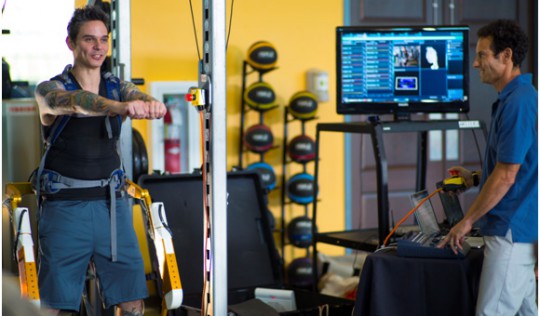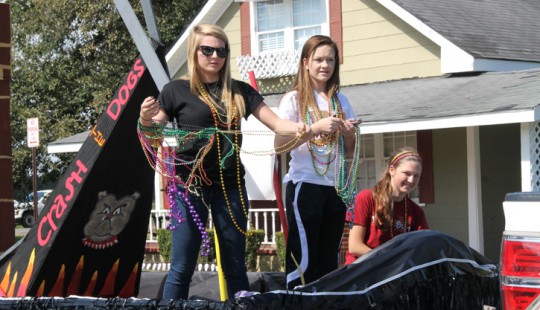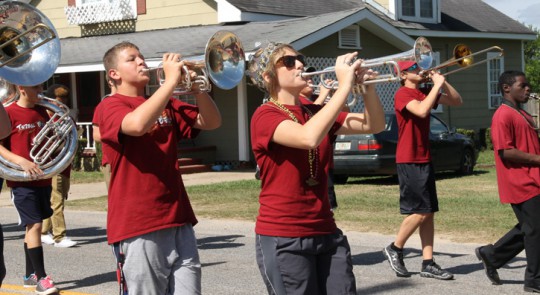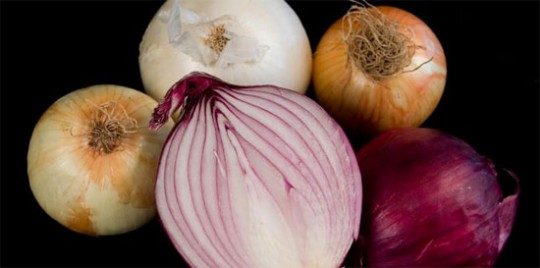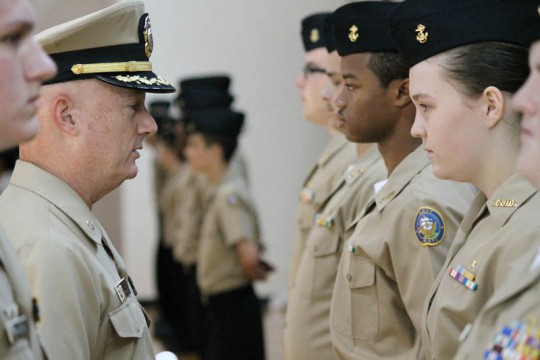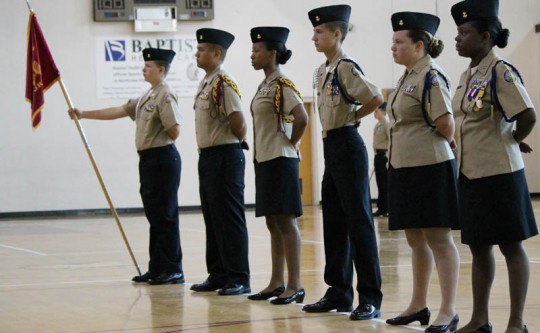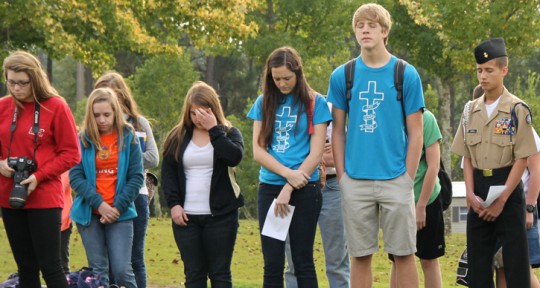UF/IFAS Moves Closer In Quest For Peanut That Won’t Cause Allergic Reaction
September 30, 2014
A University of Florida scientist has moved one step closer to his goal of eliminating 99.9 percent of peanut allergens by removing 80 percent of them in whole peanuts.
Scientists must eliminate peanut allergens below a certain threshold for patients to be safe, said Wade Yang, an assistant professor in food science and human nutrition and member of UF’s Institute of Food and Agricultural Sciences.
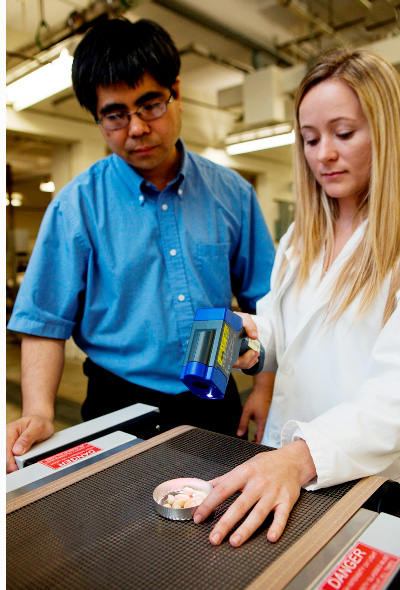 If Yang can cut the allergens from 150 milligrams of protein per peanut to below 1.5 milligrams, 95 percent of those with peanut allergies would be safe. It’s challenging to eliminate all peanut allergens, he said, because doing so may risk destroying peanuts’ texture, color, flavor and nutrition. But he said he’s using novel methods like pulsed light to reach an allergen level that will protect most people.
If Yang can cut the allergens from 150 milligrams of protein per peanut to below 1.5 milligrams, 95 percent of those with peanut allergies would be safe. It’s challenging to eliminate all peanut allergens, he said, because doing so may risk destroying peanuts’ texture, color, flavor and nutrition. But he said he’s using novel methods like pulsed light to reach an allergen level that will protect most people.
Yang, whose study is published online in this month’s issue of the journal Food and Bioprocess Technology, cautioned that he has done peanut allergen experiments only in a laboratory setting so far. He hopes to eventually conduct clinical trials on animals and humans.
Dr. Shih-Wen Huang, professor emeritus in the Department of Pediatrics and Head of the Pediatric Allergy Clinic at UF Health, is familiar with the UF/IFAS research. Huang outlined more steps in the peanut allergen research.
“I am pleased to see their work is progressing well,” Huang said. “However, more challenges are waiting until the final products are accepted from the public, especially the patients with peanut allergies.”
Two years ago, Yang was using his technique on peanut extract. He’s now testing it on the peanut itself. In his 2012 study, he removed up to 90 percent of the allergic potential from peanut protein extracts.
“This process proves that pulsed light can inactivate the peanut allergenic proteins and indicates that pulsed light has a great potential in peanut allergen mitigation,” Yang said.
About 1.9 million people, or 0.06 percent of U.S. residents, are allergic to peanuts, according to the National Institute of Allergy and Infectious Diseases, part of the National Institutes of Health.
Reactions can range from skin rashes to anaphylaxis, which can be fatal. Currently, the best way for those allergic to peanuts to stay safe is to avoid them, according to the NIH. Many people carry epinephrine injectors that help offset their allergy symptoms until they reach a hospital.
Pictured: Wade Yang, left, an assistant professor in food science and human nutrition at UF/IFAS, used pulsed light to remove 80 percent of the allergens from a whole peanut. By doing so, he moves closer to his goal of eliminating 99.9 percent of allergens in peanuts. Courtesy photo for NorthEscambia.com, click to enlarge.
Exoskelton Created In Escambia County To Be Featured On Discovery Channel
September 29, 2014
An upcoming segment of The Discovery Channel’s Daily Planet program will feature a new exercise exoskeleton developed by researchers at the Florida Institute for Human and Machine Cognition (IHMC) in Pensacola.
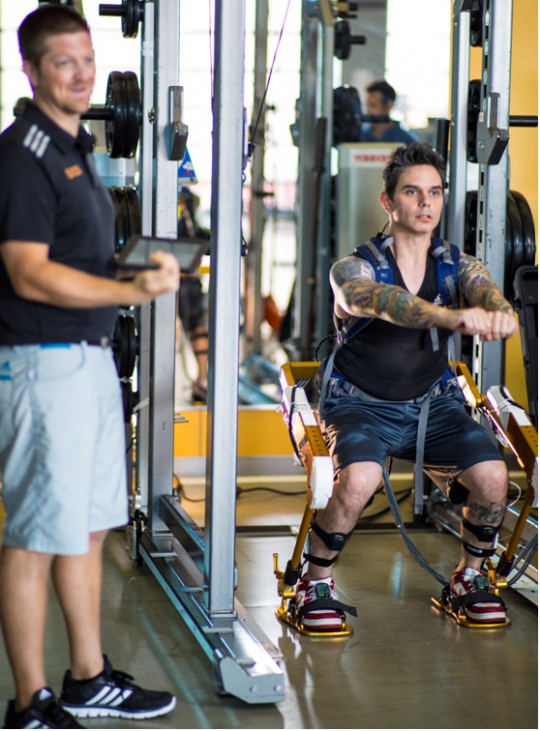 Called the Grasshopper, or Hopper, the device was designed, built and tested as part of a NASA-funded project exploring the use of robotic exoskeletons for microgravity exercise. Because the Hopper uses motors instead of gravity to create the load on the user, the device is suited for use on space missions. Exercise in zero-gravity conditions is critical to maintain muscle strength and bone mass.
Called the Grasshopper, or Hopper, the device was designed, built and tested as part of a NASA-funded project exploring the use of robotic exoskeletons for microgravity exercise. Because the Hopper uses motors instead of gravity to create the load on the user, the device is suited for use on space missions. Exercise in zero-gravity conditions is critical to maintain muscle strength and bone mass.
The Hopper is designed to replicate the effect of squat exercise with free weights, and its associated loading on the body. To test this claim, the Hopper was brought to EXOS, a leader in integrated performance training, nutrition and physical therapy for professional and elite athletes, the military and innovative corporations.
The IHMC team is led by Senior Research Scientist Peter Neuhaus. Members include Research Associate Nick Payton and student interns Travis Craig and Jeremy Gines. Noraxon, a company specializing in evidence-based biomechanics, provided sensors and technical analysis to compare exercise using the Hopper versus use of free weights.
The Daily Planet segment was filmed at IHMC and the EXOS center in Gulf Breeze. The shows host, Lucas Cochran, was instrumented with the Noraxon sensors and coached by an EXOS specialist on how to properly perform the squat motion, both with free weights and while strapped into the Hopper. The data showed that his muscles and heart responded in very similar fashion while using either the Hopper or the free weights. In addition, Cochran reported that the Hopper was more comfortable than free weights for a similar weight.
The Daily Planet segment will air late October 2014.
Pictured top: IHMC Senior Research Scientists Peter Neuhaus, right, works with Lucas Cochran, left, during testing of the IHMC exoskeleton Grasshopper during filming of the Discovery Channel’s Daily Planet program. Pictured inset: Cochran works out in the IHMC exoskeleton Grasshopper. At left is Stefan Underwood from EXOS, Photos for NorthEscambia.com, click to enlarge.
Northview Homecoming Parade Entry Deadline Is Tuesday; Homecoming Meal Available
September 29, 2014
The sixth annual Northview High School Homecoming Parade is Friday, and the deadline for entries is tomorrow.
The parade will line up at noon and travel from Bratt Elementary School to Northview High. Entries are being accepted now; there is no cost to enter. For a printable entry form, click here. Entries are due by Tuesday.
Contact Perry Byars at (850) 327-6681 ext. 248 for more information.
A homecoming meal will available Friday from 10 a.m. until 12:30 p.m. from the football concession stand to support the Tommy Weaver Scholarship Fund. The $7 meal will include a BBQ pork sandwich, chips, dessert and drink. Call in large orders by Wednesday to Perry Byars at (850) 327-6681 ext. 248 if 10 or more meals are desired. Meal prepared by Archie’s Catering Services.
The Northview Chief’s homecoming game will kickoff at 7 p.m. on October 3 against the Jay Royals.
Pictured: The 2013 Northview High School Homecoming Parade. NorthEscambia.com file photos, click to enlarge.
Weekend Gardening: Now’s The Time To Plant Onions
September 27, 2014
by the Santa Rosa Extension Service
Onions are sold in every grocery store, served at many meal and featured at sporting events across the United States. Onions are everywhere. If you’ve ever wanted to try to grow them, now is the time to plant.
Edible onions have been cultivated for so long that it is difficult to trace their origin. Onions were first introduced to America around the turn of the century when a retired French soldier brought some onion seeds from Corsica to the Walla Walla region of the Pacific Northwest. But it wasn’t until the farmers in Georgia realized what a special thing they had in the Vidalia onion and began spreading the news that the sweet onion finally got the attention it deserves.
Onions have different requirements as to the number of hours of daylight required for bulb formation. The types that require 15 to 16 hours of light daily are referred to as “long day” varieties and not adapted for the South. Types that grow best in Florida are the “short-day” varieties. They must be started in the fall so that bulbing is induced by the short days of winter. However, the subsequent harvest of bulbs follows in the spring or early summer.
Onions are often grouped according to taste (mild and strong flavored), color (white, yellow, and red) and use (storage or freshly eaten). Some suggested bulbing onion varieties for Florida include Excel, Texas Grano, Granex, White Granex and Tropicana Red.
Yellow onions are gardeners’ most popular choices. Granex 33 is the early Texas hybrid grown in Vidalia, Georgia. Texas Grano 1015Y Aggie Sweet produces a large, mild bulb that is very sweet under the right growing and soil conditions. The Texas Grano 502 is well known for large, mild bulbs with fair storage potential.
Onions are grown either from seed, sets (tiny immature bulbs) or transplants. The planting method selected is based on cost, use, availability, and planting ease.
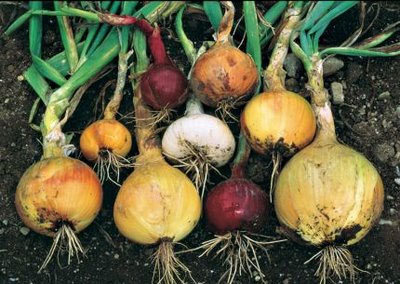 Onions grown from sets do not make the best bulbs, and are rather costly. Specific onion varieties are usually not available. They are sold simply as red, white, or yellow onion sets. Since the variety is unknown, the flavor, use, and keeping quality of onions grown from sets varies considerably. Avoid sets more than an inch in diameter, as they are likely to bolt. Late plantings are more susceptible to cold or freeze injury. Planting too early can result in increased seed stem production.
Onions grown from sets do not make the best bulbs, and are rather costly. Specific onion varieties are usually not available. They are sold simply as red, white, or yellow onion sets. Since the variety is unknown, the flavor, use, and keeping quality of onions grown from sets varies considerably. Avoid sets more than an inch in diameter, as they are likely to bolt. Late plantings are more susceptible to cold or freeze injury. Planting too early can result in increased seed stem production.
Growing onions from seed may be the most difficult planting method. However, it is the least expensive and offers the greatest variety. Germination may be sporadic and plant growth can be slow. Be aware that onion seed does not remain viable long, and should not be planted when more than one year old.
In North Florida, onions can be started between mid-September and mid-November. Onion seed can be planted directly in the garden or in flats. Sow eight to 12 seeds per foot of row ½ to one inch deep. If larger bulbs are desired, thin to a final spacing of four to six inches apart.
Set out transplants from late December through February. Plants should be about 6 inches high and about half the thickness of a lead pencil at the time of transplanting. Set plants with the bottom of the plant about 1 to 1½ inch below the surface of the soil. Transplants should be spaced 3 to 4 inches apart in the row.
Onions have a shallow, poorly developed root system, so regular fertilization and watering are essential. Inconsistent watering may lead to splits, doubles and small bulbs. Fertilize the crop monthly with a nitrogen fertilizer. Be sure to keep the fertilizer from contacting the plants directly.
Good weed control is a must. Since young onions are small and grow slowly at first, they can be taken over by weeds that reduce yield. Look out for diseases before they become established. Leaf blight diseases can seriously reduce yields. Monitor for insects twice each week, and use appropriate management techniques. Contact your local Extension Office for the latest information on pest management recommendations.
Bad Boys, Whatcha Gonna Do When They Come For You? Meet Century CI’s New K-9 Pups
September 25, 2014
They are cute. They are adorable. They are adorably cute. But they could also be your worse nightmare if you are a convict on the run, or a cute little blessing if you are lost in the woods.
These cute (have we mentioned that enough yet?) little puppies are K-9 tracking dogs in training in the Century Correctional Institution.
The Florida Department of Corrections has 38 K-9 programs statewide which are used to support other law enforcement agencies with felon apprehension, searching for missing persons and locating and providing aid to persons in distress.
NorthEscambia.com photos, click to enlarge.
Standing Strong: NJROTC Annual Inspection Held (With Photo Gallery)
September 25, 2014
Northview High School’s NJROTC Annual Inspection was held Wednesday at the school, with cadets undergoing face to face scrutiny with a retired Navy commander.
 Commander Merlin Ladner, USN (Ret) conducted the inspection. The day’s events began with a personnel inspection, drill demonstration and a pass-in-review in the school gym. The commander also conducted a financial record review, briefings, administrative inspections, supply inspections and more.
Commander Merlin Ladner, USN (Ret) conducted the inspection. The day’s events began with a personnel inspection, drill demonstration and a pass-in-review in the school gym. The commander also conducted a financial record review, briefings, administrative inspections, supply inspections and more.
One by one, Cmdr. Ladner went face to face with each cadet, asking them questions about their NJROTC experience and conducting a complete inspection of their uniform.
“Yes, sir,” the cadets answered as they faced the questions about their NJROTC service, their ribbons, the shine on their shoes and some less than expected questions about every day life and football that left some cadets trying not to crack a smile.
“They did a very fine job this morning” said Ladner, who conducts annual inspections at dozens of high schools in the Southeast, told the entire group following his inspection. “And they are working their way to the top of my 50 or so units.”
Northview’s NJROTC is under the command of Senior Naval Science Instructor Captain Charlie Code and Chief Jeffrey Simpkins. The unit is led by Company Commander LCDR Lane Carnley and Executive Officer Cadet LT Sean Allister.
For a photo gallery from the inspection, click here.
Pictured: Northview High School’s NJROTC Annual Inspection Wednesday morning. NorthEscambia.com photos, click to enlarge.
Hundreds Of Students Gather To Pray At The Pole (With Photo Gallery)
September 24, 2014
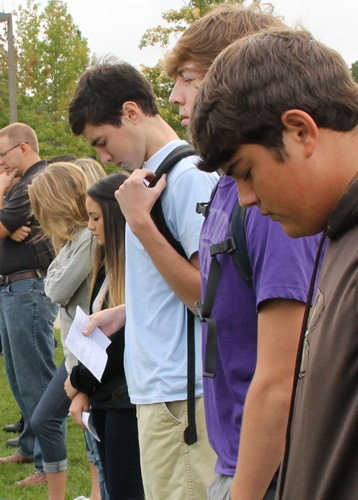
Hundreds of students gathered to pray at their schools in across the area Wednesday morning during the annual See You at the Pole event.
Students gathered as school began to pray in the non-denominational event. See You at the Pole is a student-initiated, student organized, and student-led event. Students prayed for their school, friends, teachers, government and the nation.
For a photo gallery, click here.
Pictured top and inset: See You at the Pole Wednesday morning at Northview High School. Pictured below: Ernest Ward Middle School. NorthEscambia.com photo, click to enlarge.
Highland Baptist Donates Paper To Molino Park Elementary
September 24, 2014
Highland Baptist Church, a Molino Park Elementary School Partner in Education, delivered 17 boxes of paper to the school this week. Each year, the church collects paper and school supplies at the beginning of the year to benefit Molino Park.
“We are so thankful for their continued support,” Principal Alice Woodward said. “Thank you to everyone that took part in this awesome donation.”
Pictured: Highland Pastor Brian Calhoun and Charles Woodward deliver a paper donation to Molino Park Elementary School. Photo for NorthEscambia.com, click to enlarge.
Northview Yearbook Receives Top Columbia Scholastic Press Association Award
September 23, 2014
The Northview High School Tribal Spirit yearbook staff has been honored with a Gold Medal from the nationally recognized Columbia Scholastic Press Association, affiliated with Columbia University in New York City and the Columbia Graduate School of Journalism.
The book received 910 points out of a maximum 1000 points to place it well within the Gold category (800-1000 points.) Yearbooks are judged in three areas – reference, verbal, and
visual. In the visual category, Northview received 388 points out of a possible 400, earning them All-Columbian Honors for Visual.
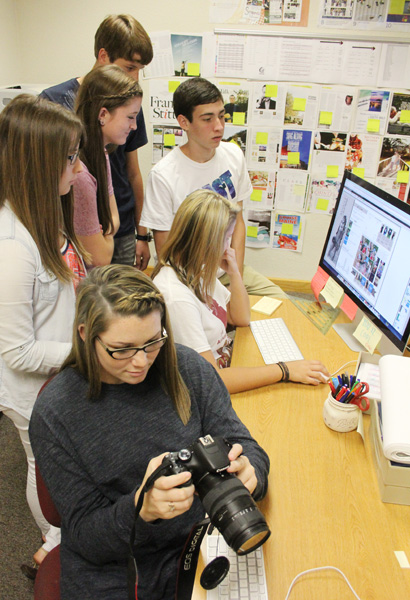 This was the first year that they entered their yearbook for critique. The purpose of the critiques and medal awards is to direct students and advisers toward a better publication through growing in knowledge of correct journalism standards.
This was the first year that they entered their yearbook for critique. The purpose of the critiques and medal awards is to direct students and advisers toward a better publication through growing in knowledge of correct journalism standards.
“It was a pleasure to read and critique the 2014 Tribal Spirit Yearbook. It was quite evident that you and your fine staff contributed countless hours to produce this commendable publication. You especially excelled in achieving a strong grasp of journalism standards, writing skills, and photography techniques,” the judges commented.
The Tribal Spirit yearbook staff and their adviser, Alison Robinson, attended the Columbia Scholastic Press Association Convention in New York City in 2011 and 2013.
“Being on yearbook staff teaches life skills and technical skills that are unsurpassed in any other course. The students on this staff learn manual photography, how to make sales, write copy and captions, create and properly use graphic design, but mostly how to take constructive criticism and use it to improve themselves,” Robinson, a 20-year veteran staff adviser, said. “They have seen the results of constantly designing pages and taking pictures over and over until they get those technical aspects right. This is an ongoing learning process. The staffers work together on every part of the book and learn to use each individual’s strengths to fortify the team. It is because of their grit and determination that they have reached the Gold Medal level.”
Tamara Green, a 2014 senior editor said, “Receiving this award means so much to me because I know that we all worked so hard throughout the school year. Not every day was easy, but with much hard work and determination, we created a yearbook that was definitely one to remember.”
Another senior editor for the 2014 book, Dalton Daniel, said “I know we all put forth 110% to our work, and that’s what got us this medal.”
Yearbook Staff members for the Columbia Scholastic Press Association award-winning 2014 edition were – editors Justin King, Anna Fischer, Dalton Daniel, and Tamara Green; and Kamryn Brock, Jessica McCullough, Haylee Weaver, Bethany Reynolds, David Thorpe, Jessica Amerson, Mitchell Singleton, and David Weber.
To order this school year’s Northview High School Tribal Spirit yearbook, click here.
Pictured: Current Northview Tribal Spirit Yearbook staff members David Weber (standing background), Bradley Van Pelt (white shirt)), Jordan Taylor (standing), Bethany Reynolds (standing, foreground), Kamryn Brock (seated at computer) and Jessica McCullough (with camera). Photo for NorthEscambia.com, click to enlarge.
Local Students Awarded Take Stock In Children Scholarships
September 23, 2014
Recently, 26 students — including several from the North Escambia area — were introduced as new Take Stock in Children scholarship recipients. The Escambia County Public Schools Foundation introduced the students at the annual Take Stock in Children Kick-Off Dinner, bringing the total number of students in the program to 118 in Escambia County.
 These students are currently in grades 7-12 and they will receive a college scholarship upon graduation from high school, as long as they maintain program standards. Students sign an agreement to maintain good grades and attendance; to be good citizens; to remain crime and drug free; and to meet weekly with a volunteer community mentor.
These students are currently in grades 7-12 and they will receive a college scholarship upon graduation from high school, as long as they maintain program standards. Students sign an agreement to maintain good grades and attendance; to be good citizens; to remain crime and drug free; and to meet weekly with a volunteer community mentor.
Take Stock in Children is a statewide, non-profit organization that provides “scholarships, mentors and hope” to deserving young people selected through a need-based application process. They are identified by their public middle schools at the end of their sixth grade year. Twenty-one of the new students are seventh graders and five others were selected from previous years’ alternate lists.
New students, their mentor and their school include:
- Mya Acoba, mentor Mari Abbate, Brown Barge Middle
- Savanna Bowen, mentor Lynne Bates, Ransom Middle
- Brandon Brantley, mentor Dave Bates, Bellview Middle
- Sylvia Callihan, mentor Veronica Dias, Warrington Middle
- Tristan Cravatt, mentor Jack McNulty, Bailey Middle
- Breona Dean, mentor Fernaundra Ferguson, Ferry Pass Middle
- Lucas Dinsmore, mentor Pete King, Bailey Middle
- Lina Foust, mentor Anita Prentiss, Pine Forest High
- Diamond Franklin, mentor Ruth Jenkins, Escambia High
- Morgan Garner, mentor Neeltje McNulty, Bailey Middle
- Ian Gifford, mentor Bob Goforth, Ernest Ward Middle
- Angel Goldsby, mentor Stephanie Noa, Workman Middle
- Haley Hennington, mentor Mallory Studer, Bellview Middle
- Madison Hurston, mentor Cindy Barrington, Ransom Middle
- Issiah Johnson, mentor Ken Biland, Bailey Middle
- Lari McCann, mentor Cynthia Worrell-White, Northview High
- Thinh Pham, mentor John Fromularo, Warrington Middle
- Annemarie Pigg, mentor Susan Myrick, Bailey Middle
- Ben Potts, mentor Rusty Branch, Brown Barge Middle
- Malcolm Pressley, mentor Andy Arnold, Workman Middle
- Teriana Redmond, mentor Sherri Stallworth, Ernest Ward Middle
- Ashleigh Smith, mentor Freida Nichols, Ferry Pass Middle
- Kiplin Smith, mentor Charity Hamilton, Workman Middle
- Taylor Smith, mentor Sandra Durr, Tate High
- Austin Witt, mentor Bob Hoyt, Woodham Middle
- Ashten Wright, mentor Ray Sellers, Ernest Ward Middle
Money for each scholarship is donated locally and a dollar-for-dollar match is received from Florida Prepaid College Foundation when scholarships are purchased.


